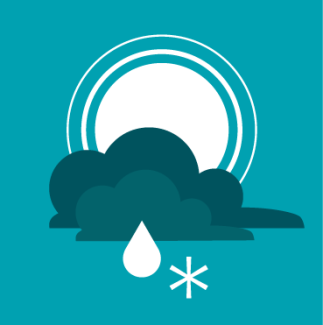Atmosphere Data Theme

Atmospheric science is the comprehensive study of the physical and chemical dynamics of Earth’s atmosphere. NEON collects a variety of atmospheric measurements at field sites to detect climate change. NEON atmospheric data range from fundamental meteorological variables, such as temperature, precipitation and atmospheric pressure, to aerosol concentrations and net ecosystem exchange. The project integrates atmospheric data with airborne remote sensing data and existing satellite data to support continental-scale understanding and forecasting of climate change.
NEON atmospheric data
In order to understand atmospheric change, NEON measures certain characteristics at field sites, such as:
- Concentrations and fluxes of greenhouse gases;
- The rate, quantity and chemical composition of precipitation; and
- Physical climate such as temperature, radiation and wind.
NEON atmospheric measurements and resulting data products characterize climate and carbon transfer between the atmosphere, vegetation and soil. These measurements may be combined with NEON airborne remote sensing data and existing satellite data to support modeling of carbon fluxes, soil moisture and evapotranspiration across the continent. In turn, these data support research and predictive models of global change.
Ecological relevance
Atmospheric properties such as temperature, radiation and CO2 concentration respond to and drive changes in ecological function and health that affect essential ecosystem services, such as carbon storage and food production. For example, greenhouse gas emissions continue to alter the chemical composition of the atmosphere at unprecedented rates, leading to compounding changes in climate and considerable impacts on plant and animal communities. Consistent, high-quality data are needed to improve ecological understanding and forecasting. NEON produces such data to support the complex study of atmospheric change and resulting impacts, ranging from impacts on biodiversity to human health.
Research applications
NEON colocates atmospheric measurements with other scientific measurements, providing a unique opportunity to examine ecological change across relevant space and time scales. NEON data may be used to address complex ecological questions, such as:
- How does the transportation of dust in the inter-mountain west affect the timing of snowmelt?
- How do elevated carbon dioxide concentrations, nitrogen deposition and ozone exposure interact to affect plant populations and communities?
Key categories of measurements
- Physical climate: aerosols, precipitation, radiation, and temperature, pressure and wind
- Chemical climate: wet deposition, chemistry, isotopes and scalar concentrations
- Net ecosystem exchange: carbon dioxide (CO2) flux, soil CO2 flux, water vapor and latent heat flux, sensible heat, total reactive nitrogen (NOy) and ozone (O3)